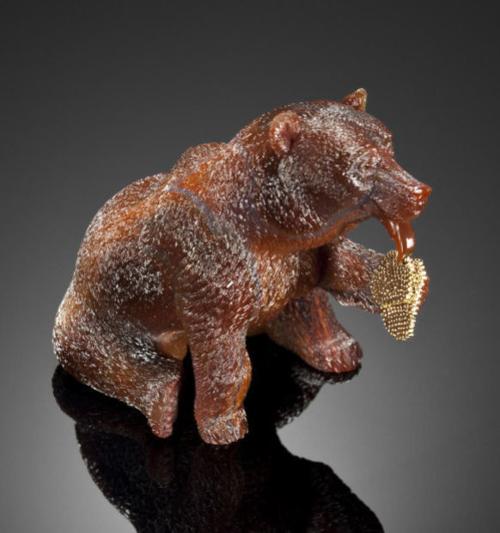Q: I bought this hand-carved bear sculpture from The Teddy Bear Museum in Naples, Florida, when it closed in 2005. It had been donated by a Texas collector. I was told by an antique bear collector that it’s worth $3,000 to $4,000 today. Your opinion?
A: Our reader adds that she paid $1,000 for the 3¼-inch-tall piece with paper tags on the bottom. They read $1,800 and Abercrombie and Fitch.
The bear seen in images sent is an example of lapidary art, where an artist or artisan carves, cuts or grinds stone, minerals or gemstones to form a decorative item. Cameos are one example, though lapidary figures, especially animals or objects in nature, have become increasingly popular. Of course, top examples by Faberge are now extremely rare and close to priceless.
Abercrombie and Fitch would seem an odd match with lapidary until one remembers the firm’s origins linked to natural history and discovery. At some point, the bear apparently retailed there for $1,800.
Coming from a museum does not automatically confer value. Objects end up in museums for all sorts of reasons, and de-accessions from only specific collections and museums matter.
Certified Graduate Jeweler Gemologist Claudia Florian has built an audience for lapidary arts through more than a decade of Natural History sales at Bonhams. After a look at the reader’s images, she told us, “I see bucket loads of this quality.”
Typically carved in Germany, where lapidary is a cottage industry, work created by generations of carvers has become well-known. Carvers in and around Idar-Oberstein are especially celebrated.
Smart collectors know that bear carving is a German specialty. Another example is Black Forest carvings of wood, where examples are found at varied levels of skill.
The reader’s bear is a production piece made for sale to tourists or for export. Created by an anonymous carver, it’s a type commonly found.
Carved from less desirable light gray or brown agate, the cutting of the bear shows little finesse. He is crudely shaped, with chunky cuts and clumsy paws. And the depiction of the standing bear in an awkward stance is clumsy.
In contrast, note the characteristics of a museum-quality bear photographed with this column. First, it’s carved from a piece of agate selected for color. The rich color, the detailing of the fur and the high gloss achieved by master cutting show the fine touch of a premier carver.
All that, plus the reputation of the carver goes a long way to explaining the $21,250 sale result.
I’d love to know what criteria that antique bear collector used to reach such an astounding price estimate for you. To put it bluntly, friends mean well, but most don’t have the foggiest notion of true values. I’ve yet to see a friend-referred price in a query (and there are many) that’s close to accurate and not wildly inflated.
Florian estimates an auction result of around $1,000 on the reader’s bear.
“Look for monogram initials on the bottom of a paw,” she adds. A signed piece is more desirable.





